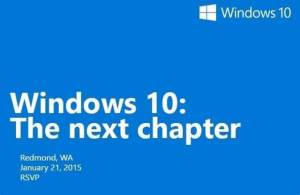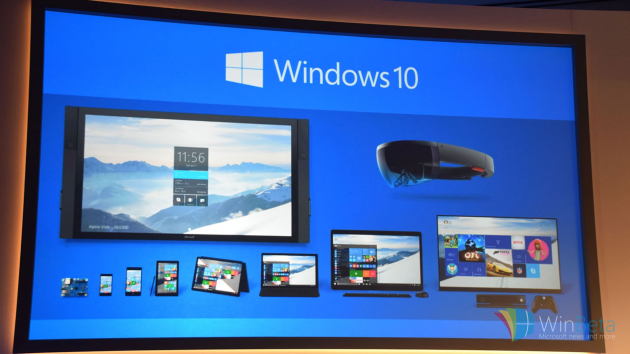Microsoft Unveils Windows 10, HoloLens, and Surface Hub at Highly Anticipated Jan. 21st Event
On Wednesday at its campus in Redmond, Washington, Microsoft unveiled the much-awaited Windows 10. The software giant also introduced an intriguing HoloLens hologram device and a massive smart whiteboard called the Surface Hub. We've got the scoop on all this below:
The Surface Hub is an Awesome Smart Whiteboard
What exactly is a “smart whiteboard,” you ask? Think of an 84-inch tablet with a 4k resolution. It is intended to serve as an enterprise product geared towards businesses that need the best smart technology for their conferences and presentations. The Surface Hub comes equipped with some nice speakers, a high-quality built-in camera, and of course it is WiFi-capable as any smaller tablet would be.
Free Windows 10 Upgrade Confirmed But No Release Date Given
 Microsoft also confirmed the rumor that users of Windows 7 or 8.1 would be able to upgrade to Windows 10 for free within the first year. We assume this means that other Windows users will have to wait until next year to get the upgrade for free, or they may have to purchase Windows 10 outright.
Microsoft also confirmed the rumor that users of Windows 7 or 8.1 would be able to upgrade to Windows 10 for free within the first year. We assume this means that other Windows users will have to wait until next year to get the upgrade for free, or they may have to purchase Windows 10 outright.
For now, there's always the Windows 10 Technical Preview available for free, and you can run that in a virtual machine if you want to get a sneak peek of what the new operating system can do.
Unfortunately, Microsoft still did not give an official release date for Windows 10, nor did we get a release date for the awesome HoloLens goggles that are expected to come out this year as well. Fortunately, you can get a sneak peak of the headset in action by checking out Wired's hands-on with the HoloLens, and there should be new Windows 10 builds released in the coming months as well.
The new browser called Spartan
A couple weeks ago we covered a leak about the features of Microsoft's next-generation web browser Spartan, which will replace the struggling Internet Explorer in Windows 10. The goal with this new browser is to create a web surfing experience that feels similar across all devices, from smartphones to laptops to desktops. Microsoft apparently wants mobile users to utilize their mobile browsers just as often as desktop users browse the web.
Currently, mobile browsers act and look very different from desktop browsers (they're minimalistic in comparison), and because so many people find it easier to navigate the full desktop version of a website, most choose to use their desktop browser far more often than their mobile browser.
The Spartan browser is an attempt to unify the experience so that companies don't have to produce limited mobile versions of their site and visitors don't have to be using a laptop or desktop to access certain areas of the site. Overall, the philosophy is that mobile users should be able to enjoy a web that is as full-featured as the internet they see on their PC, all under the umbrella of Windows 10 of course.
HoloLens Steals the Show
One of the most exciting announcements was the confirmation that Windows 10 will indeed be able to run on nearly all modern devices. While most of us expected the operating system itself to be the main topic of discussion at the event (and for the most part it was), surprisingly enough, an entirely different device came to steal the show with the illustrious power of holographic imagery.
The revolutionary new HoloLens headgear (which will also run on Windows 10) can project holograms onto a lens in your goggles, giving the appearance that the projections are actually holograms existing in the world around you. This may disappoint some people who were expecting to see full-blown holograms in their living rooms, but still, it makes for one extremely interesting mixed reality device – mixed reality combines virtual reality and augmented reality.
There is no keyboard, mouse, joystick, or any other tangible control unit; the holographic computer is completely wireless and utilizes only hand and voice gestures for control. So developers will ave to make sure they get the controls perfect before releasing it to the public, as the user won't be able to resort to using a secondary input device (like a keyboard) if they're unable to properly command HoloLens.
The user can use HoloLens as a holographic phonepad, watch holographic televisions, and design and create 3D holographic objects. The HoloLens is even compatible with 3D printers, so you'll be able to print your holographic creations as well. It will be interesting to see what modern architects will be able to do with a combination of holographic headsets and 3D printers in the near future. Recently, the first 3D-printed apartment building was constructed in China.
There was also news that there will be holographic versions of Minecraft and Skype, and of course it will be very interesting to follow the development of holographic games. Exploring maps, interacting with images, and viewing online media would all be completely new experiences with holograms, which give the viewer the impression that they can reach out and touch the projected object in front of them.
In the long-term, holographic devices may even prove to be more useful than the more immersive, enveloping, and obstructive virtual reality headsets, as holograms have been shown to produce highly accurate imagery (take this Tupac hologram concert for example).
The Takeaway
So far, 2015 is shaping up to be a tremendous year in tech. There's the gradual advent of wearables and virtual reality with the upcoming iWatch and Oculus Rift on the horizon. Then there's a slew of new 3D printers and even worthy glasses-free 3D displays coming out as well. To top it all off, Microsoft is going all out and crossing device platforms in Windows, while also introducing one of the first powerful consumer holographic products in commercial technology. The combination of virtual reality, holograms, and a headset like HoloLens entering into society, could catapult us into a future sci-fi-like existence a lot sooner than you might imagine.

